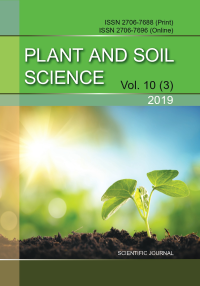Influence of salicylic acid solution on the content of enzymes content in sour cherries fruit during storage
DOI:
https://doi.org/10.31548/agr2019.03.049Keywords:
cherry fruit, respiration rate, enzymes, salicylic acAbstract
Fruits of cherries play an important role in human nutrition, but they have a short term of consumption due to seasonal production. Therefore, the problem of extending their consumption period becomes relevant. The aim of the research was to determine the effect of pre-treatment with salicylic acid solution on the change in the intensity of respiration and cavity activity of cherry fruit. For research purposes, the crops of the Shpanka and Lyotovka 2017-2018 crops were harvested with an aqueous solution of 50 mg/l or 100 mg/l of salicylic acid per day before harvesting. Dried by natural way. After 24 hours, the fruits were taken from trees and put into boxes № 5 for 5 kg each. For control, raw fruits of cherries were taken. The fruits were stored in the refrigerating chamber of the technology of storage and processing of fruits and vegetables at a temperature of 5±0.5 °С and a relative humidity of 95±1%.
It was found that the intensity of respiration was varied and depended on the characteristics of the variety and the method of treatment. At the end of storage, it remained the lowest for cherry fruit, treated with 100 mg/l salicylic acid solution − by 33–46%. At the same time, the activity of the catalase enzyme changed during storage and was higher in the cherry fruits of the varieties Shpanka and Lotovka, treated with 100 mg/l salicylic acid solution, by 21 and 32%.References
Prіss, O.P., Zagorko, N.P. (2016). Vpliv teplovoї obrobki bіologіchno aktivnimi rechovinami na funkcіonuvannja sistemi niz'komolekuljarnih antioksidantіv pіd chas zberіgannja plodіv percju. [The influence of heat treatment of biologically active substances on the functioning of the system of low molecular weight antioxidants during storage of pepper fruits]. Vіsnik NTU "HPІ", №12, 169−175.
https://doi.org/10.20998/2413-4295.2016.12.25
Valero, D., Díaz-Mula, H.M., Zapata, P.J., Castillo, S., Guillén, F., Martínez-Romero, D., Serrano, M. (2011). Postharvest treatments with salicylic acid, acetylsalicylic acid or oxalic acid delayed ripening and enhanced bioactive compounds and antioxidant capacity in sweet cherry. Journal of agricultural and food chemistry, 59 (10), 5483-5489.
https://doi.org/10.1021/jf200873j
Ramana Rao, T. V., Baraiya, N. S., Vyas, P. B., Patel, D.M. (2016). Composite coating of alginate-olive oil enriched with antioxidants enhances postharvest quality and shelf life of Ber fruit (Ziziphus mauritianaLamk. Var. Gola). Journal of Food Science and Technology, 53(1),748-756.
https://doi.org/10.1007/s13197-015-2045-3
Pasquariello, M.S., Patre, D.D., Mastrobuoni, F., Zampella, L., Scortichini, M., Petriccione, M. (2015). Influence of postharvest chitosan treatment on enzymatic browning and antioxidant enzyme activity in sweet cherry fruit. Postharvest biology and technology, 109, 45-56.
https://doi.org/10.1016/j.postharvbio.2015.06.007
Zeraatgar, H., Davarynejad, G. H., Moradinezhad, F., Abedi, B. (2018). Effect of salicylic acid and calcium nitrate spraying on qualitative properties and storability of fresh jujube fruit (Ziziphus jujube Mill.). Notulae Botanicae Horti Agrobotanici, 46(1), 138−147.
https://doi.org/10.15835/nbha46110743
Martinez-Romero, D., Alburquerque, N., Valverde, J.M., Guillen, F., Castillo, S., Valero, D., Serrano, M. (2006). Postharvest sweet cherry quality and safety maintenance by aloe vera treatment: a new edible coating. Postharvest biology and technology, 39(1), 93−100.
https://doi.org/10.1016/j.postharvbio.2005.09.006
Mittler, R. (2002). Oxidative stress, antioxidants and stress tolerance. Trends plant science, 7, 405-410.
https://doi.org/10.1007/s13197-015-2045-3
Martínez-Esplá, A., Serrano, M., Valero, D., Martínez-Romero, D., Castillo, S., Zapata, P.J. (2017). Enhancement of antioxidant systems and storability of two plum cultivars by preharvest treatments with salicylates. International journal of molecular sciences,18(9), 1911.
https://doi.org/10.3390/ijms18091911
Xu, X., Tian, S. (2008). Salicylic acid alleviated pathogen-induced oxidative stress in harvested sweet cherry fruit. Postharvest biology and technology, 49, 379-385.
https://doi.org/10.1016/j.postharvbio.2008.02.003
Valverde, J.M., Giménez, M. J., Guillén, F., Valero, D. (2015). Methyl salicylate treatments of sweet cherry trees increase antioxidant systems in fruit at harvest and during storage. Postharvest Biology and Technology, 109.
https://doi.org/10.1016/j.postharvbio.2015.06.011
Dzheneeva, S. Yu., Yvanchenko,V. Y.(1998). Metodycheskye rekomendatsyy po khranenyiu plodov, ovoshchei y vynohrada. Orhanyzatsyia y provedenyia yssledovanyi. [Methodical recommendations on the storage of fruits, vegetables and grapes. Organization and conducting of research]. Yalta: Ynstytutvynohrada y vyna «Maharach», 152.
Frukti ta ovochі svіzhі. Vіdbirannja prob DSTU ISO 874-2002. [Fresh fruits and vegetables. DSTU ISO 874-2002 Sampling]. [Chinnij vіd 2003.10.01].
Najchenko, V. M. (2001). Praktikum z tehnologії zberіgannja і pererobki plodіv ta ovochіv z osnovami tovaroznavstva: navchal'nij posіbnik. [Workshop on the technology of storage and processing of fruits and vegetables with the basics of commodity science: a textbook]. Kiїv: FADA LTD, 211.
Pochinok H.N. (1976). Metody biohimicheskogo analiza rastenij. [Methods of biochemical analysis of plants]. Kiev: Naukova dumka, 334.
Mojsejchenko, V.F. (1992). Osnovi naukovih doslіdzhen' u plodіvnictvі, ovochіvnictvі, vinogradarstvі ta tehnologії zberіgannja plodoovochevoї produkcії. [Fundamentals of scientific research in horticulture and storage technology for fruits and vegetables]. Kiїv: NMK VO, 362.
Downloads
Published
Issue
Section
License
Relationship between right holders and users shall be governed by the terms of the license Creative Commons Attribution – non-commercial – Distribution On Same Conditions 4.0 international (CC BY-NC-SA 4.0):https://creativecommons.org/licenses/by-nc-sa/4.0/deed.uk
Authors who publish with this journal agree to the following terms:
- Authors retain copyright and grant the journal right of first publication with the work simultaneously licensed under a Creative Commons Attribution License that allows others to share the work with an acknowledgement of the work's authorship and initial publication in this journal.
- Authors are able to enter into separate, additional contractual arrangements for the non-exclusive distribution of the journal's published version of the work (e.g., post it to an institutional repository or publish it in a book), with an acknowledgement of its initial publication in this journal.
- Authors are permitted and encouraged to post their work online (e.g., in institutional repositories or on their website) prior to and during the submission process, as it can lead to productive exchanges, as well as earlier and greater citation of published work (See The Effect of Open Access).

